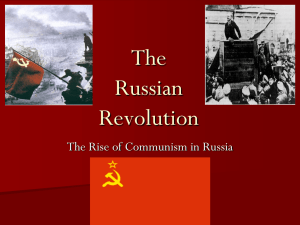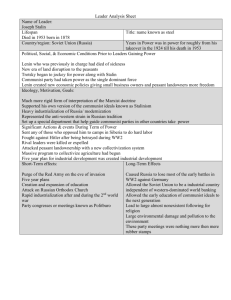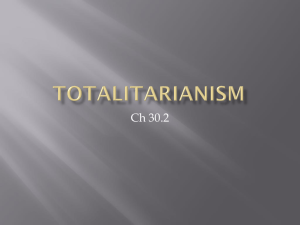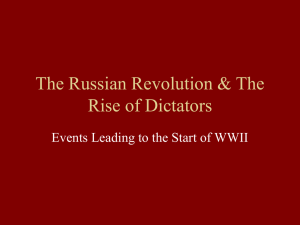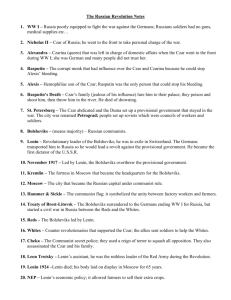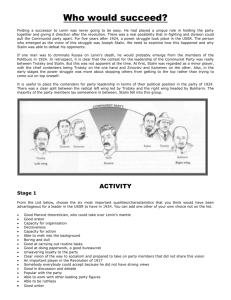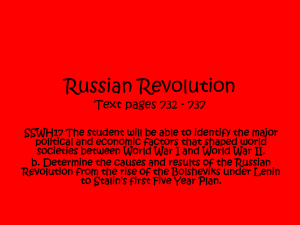Revolutions After World War I - Wappingers Central School District
advertisement
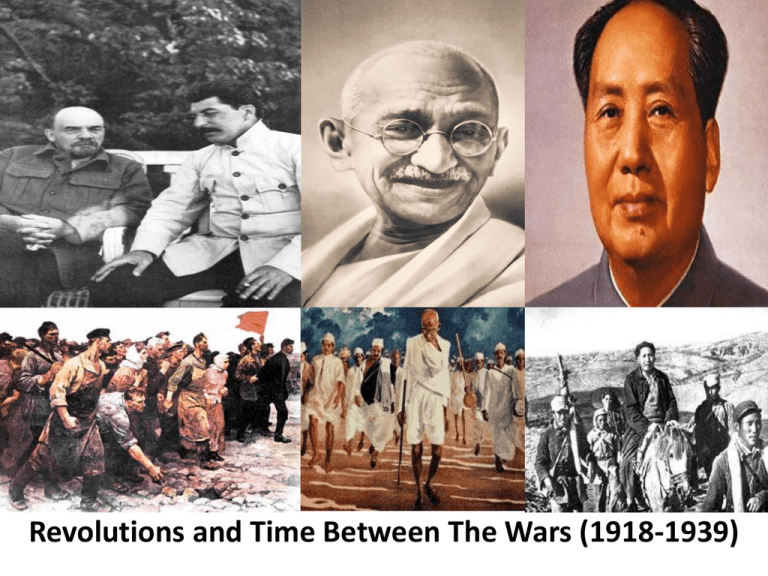
Revolutions and Time Between The Wars (1918-1939) Russia • Russia in the 1700’s – Czar (Russian king) controls everything – Peter the Great and Catherine the Great attempt to modernize Russia – Need warm- water ports for trade • Russia in the 1800’s – – – – Czar controls everything Industrial Revolution comes late to Russia Europe fears Russia’s large army Russia still a feudal society (nobles/serfs) while the rest of Europe has industrialized but are • Serfs are eventually freed (200 years after the rest of Europe) – Russia is still “backwards” (has not improved/developed) and hasn’t changed much since the 1700s. • Early 1900s – Romanov Dynasty had ruled since 1613 – Czar (means monarch) Nicholas II was on the throne – People started to lose faith after “Bloody Sunday” massacre in Jan 1905 • 1905 – Russia is defeated by Japan in the Russo- Japanese War – Russian peasants protest peacefully, but are shot by czar’s soldiers – A widespread revolt forces the czar to allow more rights, but he quickly cancels them • World War I – Russia enters to back Serbia, they join the Allied Powers – With little industry they are not prepared to fight the 1st modern war (lack technology & ability to make weapons on mass scale) • Shortage of supplies- Russian railroads can’t deliver supplies to cities • Lack of food and coal – Czar Nicolas I attempts to lead the troops personally, but fails miserably – Czarina handles the government (she is German, and not trained to rule) • Leaves control in the hands of Rasputin – They lose the most people with 5.5 million casualties • Rasputin and the Royal Family – Rasputin (“Mad Monk”) called to heal the Prince of hemophilia (blood disease), succeeds and gains family confidence – Royal family members worry about the power in the hands of the untrustworthy Rasputin – Plan to have him assassinated • The conspirators invited Rasputin over to royal palace and feed him cake and wine laced with poison • Rasputin talks on for hours • Conspirators become nervous and shoot him, after they thought he was dead he leaps up and he is shot again • His body is dumped in the near frozen river • Cause of death: Drowning • What led to the Revolutions? ***Causes were very similar to French Revolution*** – Rigid social class with a large peasant population • Denied the majority (peasant class) basic rights • Peasant class = farmers and factory workers – Spreading of liberal ideas– • New ideas changed how people thought about their government – Russian Czars were very harsh • Russian Czars attempted to westernize Russia, without importing French revolutionary liberal ideas. • Czars tried to retain power by harsh and oppressive rule. Increased discontent against absolute monarchy – Declining Economy – • Czars spent too much on luxury (ex. City of St. Petersburg) • Unable to industrialize efficiently (ex. transportation poor) • Too many losses in wars, especially World War I • Revolt of March 1917 March: Czar Nicholas taken out of power – Revolt started over: – – – – Failure of 1905 reforms shortages in food, fuel and housing too many defeats during World War I Czar abdicates (gives up) his throne • A provisional (temporary) government led by the middle class are put in place, they promise democracy – Soviets- groups of workers and soldiers revolted in the major cities and ruled themselves that support riots – The Duma, or parliament created a temporary provisional government to rule run by Alexander Kerensky – This new government continued to fight Germany and Austria- Hungary • 1917 November: “Communist Revolution” – Provisional government prove to be very ineffective, people still poor, hungry, and dying in WWI – Bolsheviks (communist), want to overtake government & make everyone equal (**no more poor vs. rich**) – 1918 Russia pulls out of WWI (Treaty of Brest-Litovsk) – Lenin and other communists are secretly shipped to Russia by Germany • They are called Bolsheviks, communists that wanted revolution – Lenin promises “Peace, land and bread” in protest in Russia 1918-1921 civil war breaks out Red Army (communist) vs. White Army (Czar supporters). Reds win. • Soldiers riot and are helped by soviets • Lenin tries immediately to end the war • Communist Russia under Lenin (1917- 1928) – Background: • Lenin’s family background instilled in him a hatred of the Czar and Czar government policies. He was influenced by the ideas of Karl Marx and as a young man he helped spread Marxist ideas. – Main Features • Leads Russian communists called Bolsheviks • First years are spent fighting a civil war- Reds vs Whites • Sets up a dictatorship to help triumph in the war – Red Army set up by Leon Trotsky – Secret police to catch bourgeois traitors – Lenin (adaptation of Marxist) ideas: – Russia had a lack of large population of urban workers – Lenin called for a/an elite group to lead a revolution. (Bolsheviks) – According to Lenin – only revolution could bring about change NOT small steps • Communism (1917- 1921) – One Party Government – Communist party the only legal party allowed. – Government structured with a constitution and elected legislature. THE REAL POWER IS HELD BY THE PARTY not the people. – People controlled by force (Military and Secret Police) – Created a new system where the government owned business – Farmers had to give their crops to the government • Distribute land to the peasants • Give workers control of the factories • New Economic Policy (1921) – During the Civil War the Bolsheviks took back control of the factories. – Lenin sets up New Economic Policy (NEP) • Government controlled all banks, large industry and foreign trade. • Some privately owned business were allowed (This form of selective capitalism was to assist in the economic recovery and not meant to be forever) • Soviet Union – By 1922 Lenin gains control over most of Russia and creates the “Union of Soviets Socialists Republics” (USSR) – Soviet Union • Moscow = Capital – Lenin Organized the nation into several self – governing republic, under the control of the central government. – Bolshevik party renamed the Communist – Party-Held total power – Lenin established a Dictatorship – By 1928, USSR farms and factories were producing as much as before WWI. – Lenin dies suddenly in 1924. A power struggle emerged for control of the Communist Party and the USSR. • Communist Russia under Stalin Background – Real name – Joseph Djugashvili, from poor family and educated in the Priesthood. Lived a very harsh existence in his younger years. – Became a radical Revolutionary Socialist after reading Karl Marx. – By 1900 he joined the Bolsheviks and took the name Stalin. (Means “Man of Steel”) – By 1920 he works his way into becoming general secretary of the party. He appoints loyal friends into key jobs which gave Stalin allies in the Government when he needed them. – Lenin did not want Stalin to be his successor. Told followers to “beware” of him. • New Party Leader: – Stalin competes with Trotsky (leader of Red Army and Lenin ally), after Lenin Dies, to succeed Lenin. Trotsky vs. Stalin: – Trotsky – scholar, great speaker, key figure in Revolution and Civil War (Well respected) – Stalin – Street smart, lacked people skills and had a minor role in the revolution. – Stalin forces Trotsky into exile by isolating – Him in the party. Installs supporters as key members in the Government. – Stalin takes control and begins his plans to modernize Russia. • Stalinism: Stalin’s version of Communism Five Year Plans: – Stalin’s idea to set production quotas / Goals that needed to be achieved in 5 years. – Focus was Industry & Agriculture ↓ Hammer & ↓ Sickle Symbol of Communism and also the Soviet flag – The Soviet Union implemented the first 5 year plan in 1928, but they never achieved their quotas despite the propaganda and Stalin’s words. – Slackers were punished severely and strictly. – Industry focused on steel, machinery and Iron made goods. – Agriculture focused on Wheat. Collectivization: (Also called Collective Farming) – Stalin NATIONALIZED all farmland (arable land) and made it property of the government. This went against Lenin’s promise to give land back to the peasants. – Peasants (especially in Ukraine) were placed on large communal farms called collectives. These were run and financed by the state. (Government) – Crops would be taken by the government and this left the peasants with very little of the crops. There was no incentive to work hard. – In 1934, Stalin punished Kulaks and peasants in the Ukraine with a forced starvation in which 10-20 million starved to death. • The Great Purge- Stalin’s Version of the Holocaust – Stalin suffered from paranoia, or a fear of others. – Stalin conducted “Purges” (systematic eliminations) of people who challenged Stalin’s ideas or were thought by Stalin to conspire against him. – Major Groups targeted in Stalin’s Purges • • • • • Kulaks Government Officials Friends Intelligentsia Army Officers (by 1938, 90% 0f Russian military officers were purged) – Approximately 25 million purged, killed or were exiled to Siberia. (Northern Russia – mostly above the Arctic Circle – Cold, harsh environment) Those exiled worked in forced labor camps called Gulags. – Most starved or froze to death – Similar to Nazi concentration camps or Chinese labor camps under Mao Zedong. • Foreign Policy – Many nations hated the communist government of the USSR – Comintern- group set up to spread revolution all over the world – Effects: USSR was isolated for most of the 1920’s and 1930’s Worldwide Issues • colonies had fought in the war and denied promises of freedom • Global Depression strikes in 1929 and quickly effects the entire world • European nations do anything to avoid war Nationalism Between the Wars in Latin America and Africa • Africa Problems – nations are colonies of Europe and were promised freedom Solutions – Nationalist groups begin forming to gain independence • Kwame Nkrumah- Ghana • Jomo Kenyatta- Kenya – Pan- Africanism – goal to unite all of Africa • Mexico Problems – Most Mexicans are poor farmers working for creole landholders – Frequent revolutions and dictatorships – Foreign nations intervene to protect their property Solutions – Nationalize businesses and land to distribute to the poor – PRI formed to help the poor and stabilize the government with a oneparty democracy – Government begins to provide education to poor Middle East Between the Wars Building a Modern Turkey Problems – The Ottoman Empire lost World War I and was divided – His people were behind the modern times – Many people wanted an Islamic government Solutions – Kemal Ataturk manages to remove Western powers from his nation – He changes Turkish culture • Separated church and state • Bans Islamic dress and traditions like polygamy • Instituted a Western calendar, alphabet, schools and government – He modernized Turkey • Hired Western experts to improve technology • Built roads, factories and railroads – Created a modern economy • Divisions in Palestine Problems – Jews had been moving in since the Zionist movement of the late 1800’s began – (Zionism’s goal is to find a Jewish homeland) – After World War I, Britain promises the land to Arab Palestinians and Jews – Both sides begin a conflict that has lasted until today • Indian Nationalism Problems – economy controlled by Britain • couldn’t trade freely • forced to make and buy British products – many fought in World War I and were promised independence – British “Raj” was sometimes cruel • Amritsar Massacre- British troops fired an unarmed peaceful demonstration killing 379 Solutions – Gandhi • Lawyer, who got his start by helping Indians in South Africa oppose unfair laws • Promoted Hindu idea of ahisma or nonviolence used satyagraha or passive resistance (Civil disobedience) – Inspired Indians to make their own goods and boycott British goods – Wore traditional clothes, but balanced Indian values with Western ones – Encouraged women to make cloth to avoid British taxes – Salt March- in 1930 he and many followers avoided a British salt tax by taking it from the sea Independence – World War II and Gandhi’s movement led to independence – Success was temporary, since Muslims and Hindus battled one another China Between the Wars • Chinese Problems 19111949 – Unstable Government • Fall of the Qing Dynasty • Warlords- local strongmen rule their areas – Civil War • fighting, between rival groups. Chiefly the Guomindang and Communists – Foreign Invasion • Japan is rewarded in the Versailles Treaty with control of Germany’s land in China. • Sun Yixian – After the fall of the Qing Dynasty, he attempts to lead China with his Three Principles-Nationalism, Democracy and livelihood – 1912- He was briefly president of China, but steps down in favor of the stronger, Yuan Shikai – 1916- Leads a revolt when Shikai tries to set up a new dynasty – 1916- 1925 Created and led the Guomindang, or nationalist party until his death in 1925 • Chang Kai- Shek (Jiang Jieshi) – 1925- takes over leadership of the Guomindang after the death of Sun Yixian – Attempts to unite China, and keep Communists out of power. – 1927- Attempts to kill communists by attacking their members in many Chinese cities. – He helps battle the Japanese from the early 1930’s until 1945. – He will lead a civil war against the Communists until he loses and retreats to Taiwan in 1949 • Mao Zedong – Leader of Chinese Communists – He retreats from the stronger Guomindang. – 1934- Long March- he is forced to lead his people through the mountains of China, of 100,000 followers, only 20,000 survive – Promises peasants land and during his struggle he takes supplies from the rich and gives any left over supplies to the poor. – He will be successful and lead China after 1949 until his death in 1976
